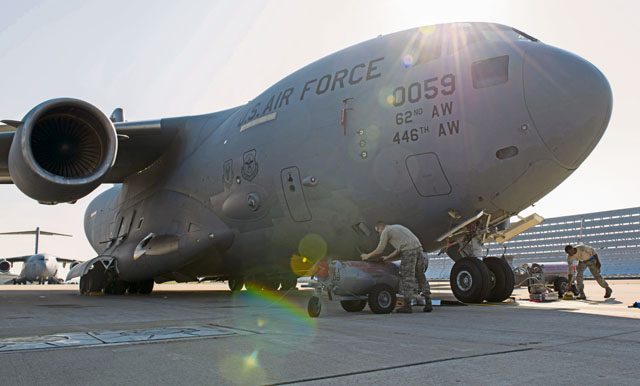
The ground rumbles as a C-17 Globemaster III taxis to the runway, sending vibrations up the soles of the feet of those on the flightline. The roar of the 280,000 pound, four-engine aircraft reverberates throughout the base before it takes off. Defying gravity, it lifts into the air and slowly disappears into the horizon.
When many people think of the Air Force, the first things that come to mind are aircraft and the pilots who fly them. But before any pilot takes to the skies, every aircraft is carefully inspected and maintained by maintenance professionals.
The 721st Aircraft Maintenance Squadron plays a large part in keeping the steady flow of aircraft, in and out of Ramstein, operational.
“Without us, these planes don’t fly,” said Master Sgt. James Blakeman, 721 AMXS C flight section chief. “Whether it’s snow, sleet, rain or a holiday, there’s always going to be a maintainer out there pushing a jet. It doesn’t matter how many pilots we have, if we don’t have a maintainer getting the airplane up, the plane’s not going anywhere.”
The squadron services C-5 Galaxy and C-17 Globemaster III aircraft transiting from the U.S. to Iraq, Afghanistan and Africa.
“Without a doubt, being an aircraft maintainer here is a lot harder than any other en route maintenance unit or any main operating base,” said Senior Master Sgt. Timothy Bugg, 721 AMXS aircraft maintenance unit superintendent. “All of our maintainers have to be fully qualified on two different airframes, whereas a home station mechanic only has to be qualified on the one aircraft that is assigned to their unit.”
Passengers such as Airmen making a permanent change of station to Ramstein and distinguished visitors as well as household goods, supplies and cargo are all delivered by the 721 AMXS.
Since July, the squadron has facilitated almost 2,700 arrivals — including 50 distinguished visitors — and more than 2,700 departures, 50 human remains movements and 400 aeromedical evacuation transports. In April, they also reached a 10-year high for the C-17 logistical departure rate at 98 percent.
The Airmen of the 721 AMXS have risen to the challenge of the increased workload that fell upon them the last few months.
“Due to the increase in missions and high number of members coming in and out, it has been very taxing on the remaining part of the squadron,” Bugg said. “Not only do they have to handle more missions, but they also have to train the newcomers as well. I think they are doing a really good job.”
According to the superintendent, they’re doing such a good job because they know their jobs inside and out.
“I think the key factor to our success is the dedication and professionalism of the workers,” Bugg said. “I can’t help but think how much these young Airmen and NCOs have to know to do their jobs. In our career field, it can take a good four to five years to be a fully qualified seven-level Airman.”
The squadron also produces mission-ready teams who are sent throughout European, Central and Africa commands to fix aircraft that have broken down in areas which do not have the capability of repairing the aircraft on their own.
Due to the long hours the 721 AMXS maintainers work, finding the time to complete upgrade and secondary training can be difficult to accomplish.
“We rely on them to stay flexible in order to make sure the mission gets pushed, and they handle it with flying colors,” Blakeman said.
Despite the high tempo of the workload at Ramstein, Bugg said he enjoys his job.
“This is my sixth assignment in the Air Force and it has been my best unit,” Bugg said. “We are busy, but it makes the days go by faster and I think we all get a feeling of accomplishment.”
Whether it’s working non-stop 12-hour shifts or spending days off completing upgrade training, the dedication of the 721 AMXS Airmen drives the Ramstein mission forward and keeps the Air Force flying high.


